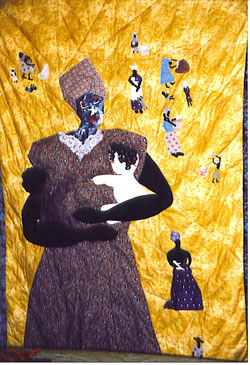
Sewing the seeds
Renowned quilter passes skills to youths
Lawrence Journal World: Sunday, December 2, 2007
By Terry Rombeck
 |
|
Sewing the seeds |
Marla A. Jackson is one of eight children born to Fern Eaton Crum and Rufus Crum Jr., originally from Royal Oak Township (a suburb of Detroit, Michigan). Marla spent most weekends and summers with her paternal grandparents, Rufus and Zelma Crum, and Lucille Crum, her great-grandmother.
Marla remembers the hand-tied quilt, made from old clothes and scraps, that her great-grandmother kept on her bed. Marla asked Grandma Lucy why she didn't buy a pretty, new bedspread. Lucille told Marla that she made the quilt herself, using pieces from clothing that belonged to family members and reminded her of special events and relationships.
Marla's artistic direction was influenced by these stories. Marla's quilts depict scenes and themes that capture the pride, spirit, pain, and joy of the African American experience.
Each of Marla Jackson's quilts tells a story. Most of these stories are personal, such as the birth of her first son. Others were born from stories shared by her great-grandmother, Lucille Crum, a former slave.
Marla's desire is to echo the untold stories of heroes that history has overlooked, forgotten or hidden. Stories that enrich the already rich heritage legitimately bestowed on Kansas, since Kansas' vital role in our nation's history regarding the issue of slavery is nationally recognized and renowned.
Marla depicts this history in her story quilts, a unique niche she has discovered to tell the stories of these heroes. She thereby helps shed light and restore to them honor for the great sacrifices they made for us all.
Children use these story quilts to assimilate history. They discover new heroes not found in their history books, while simultaneously being exposed to art. After all, they are our future leaders, teachers, and artists. Therefore, Marla's art is all the more valuable, not only for its visual appeal, but also because it visually captures oral history and events that might otherwise be forever lost.